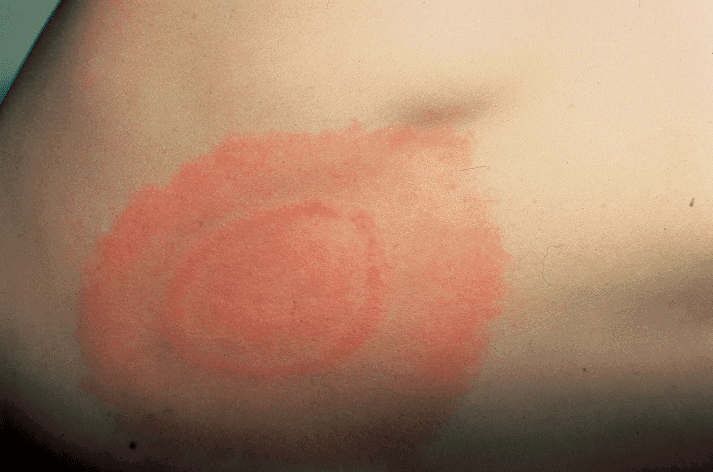If you suspect that you may be at risk for a possible tick-borne disease, be aware that tick-borne disease symptoms can take many forms and can often mimic those of other illnesses. The following article highlights some of the symptoms that can lead to common misdiagnoses of Lyme disease and other tick-borne illnesses. Be sure to discuss these warning signs and symptoms with your doctor. In many cases, more advanced lab tests are available to help provide a more precise disease diagnosis when symptoms alone are unclear.

Flu-like symptoms can be early signs of a tick-borne illness
According to the Centers for Disease Control and Prevention (CDC), the most common signs of most tick-borne diseases are fever and/or chills, muscle aches, headache, and fatigue. These flu-like symptoms can be deceptive to both patients and doctors, particularly if the patient doesn’t recall being bitten by a tick—which many patients who are diagnosed with tick-borne diseases don’t.
So how can you tell if your flu-like symptoms are really early symptoms of a tick-borne illness? A few additional symptoms to look for include:
- Rash: Patients with certain tick-borne diseases—such as Lyme disease, Southern tick-associated rash illness (STARI), Rocky Mountain Spotted Fever, Ehrlichiosis, Bartonellosis, and Tularemia—may also develop a rash at the site of the bite or elsewhere on the body, but not always. A bull’s eye-shaped rash, commonly referred to as erythema migrans (EM) rash, is often considered one of the most recognizable signs of Lyme disease. For example, fewer than 50 percent of people diagnosed with Lyme disease recall having any kind of rash. Never dismiss the possibility that your symptoms may be due to a tick-borne disease simply because you do not have a rash.
- Weakness
- Lightheadedness and/or fainting
- Relapsing fever
- Nausea and/or vomiting
- Abdominal pain
- Cough
- Sensitivity to light
- Sleep difficulty
- Muscle or joint pain and stiffness
Malaria-like symptoms could indicate a common tick-borne disease
Babesiosis is the second most common tick-borne disease in North America, with the first being Lyme disease. Spread most often by ticks in the nymphal stage, Babesiosis is a potentially deadly disease caused by a parasitic infection that mimics malaria—essentially invading and destroying the red blood cells of its host. Although some patients infected with this disease may not experience any symptoms at all, the most common signs of the disease include a high fever, sweats, nausea, headaches, and fatigue.
Giemsa stained blood smears are widely used to screen for Babesiosis. Microscopists or pathologists can sometimes identify a distinctive “cross” pattern in the infected patient’s red blood cells to differentiate Babesiosis from malaria. A FISH (fluorescent in-situ hybridization) test makes it easy to read and is more specific, not relying on morphology only.
Lyme disease could be the real cause of arthritic symptoms in children and adults

The misdiagnosis of arthritic symptoms is actually what first catapulted Lyme disease into the public spotlight more than 40 years ago. A group of adults and children in Lyme, Connecticut, were experiencing various symptoms initially attributed to rheumatoid a
rthritis (RA) and juvenile rheumatoid arthritis (JRA), respectively. The cause of the symptoms was later linked to tick bites and ultimately Borrelia burgdorferi, the bacterium that causes Lyme disease.
Today, arthritis is still one of the most common misdiagnoses of Lyme disease, especially if patients don’t recall being bitten by a tick or don’t alert doctors to the fact that they or their children have been in regions where Lyme disease is prevalent. Similar to symptoms of both RA and JRA, Lyme disease can cause joint pain, fatigue, and fever. Patients with Lyme disease, however, may also have additional symptoms—such as headache, chills, sore muscles, and swollen lymph nodes. The presence of a rash can also help distinguish Lyme disease from RA or JRA, but, again, the absence of a rash should not rule out a Lyme disease diagnosis.
Other tick-borne diseases can also produce arthritic symptoms—such as joint pain, including the relatively rare Bourbon virus and STARI. These symptoms may also be related to patients with Tick-Borne Relapsing Fever that is caused by a different group of borrelia that includes, but not limited to, Borrelia miyamotoi, a relatively new tick-borne bacterium that is distantly related to the strain of borrelia bacteria that causes Lyme disease.
Cognitive symptoms – including memory loss – can stem from tick-borne diseases
Certain tick-borne diseases can lead to cognitive difficulties that range from confusion and disorientation to dementia and other forms of memory loss. Powassan encephalitis, for example, is a potentially deadly viral brain infection that can exhibit signs of dementia. Patients with Rocky Mountain Spotted Fever, a form of rickettsiosis, may experience confusion, among other disease symptoms.
Patients with late-stage or chronic Lyme disease may also experience a number of cognitive symptoms, including depression and memory problems that can be misdiagnosed as dementia or even Alzheimer’s disease. Identifying the true cause of these symptoms can be particularly critical so that patients can receive effective treatment, particularly when they are misdiagnosed with diseases that have no known cure, such as Alzheimer’s disease.
Alerting your doctor to any exposure you might have had to areas and environments at risk for Lyme disease or other tick-borne illnesses can help lessen the chance of misdiagnosis and prompt your doctor to prescribe additional tests that can provide more accurate diagnosis of a suspected tick-borne disease.
Deeper connections between Lyme disease and other illnesses
Called the “great imitator,” Lyme disease can present a variety of symptoms that mimic a wide range of illnesses, including chronic fatigue syndrome, fibromyalgia, ALS, Alzheimer’s disease, depression, insomnia, and autoimmune disorders such as RA and Multiple Sclerosis (MS).
Keep reading to learn more about these common misdiagnoses of Lyme disease.
ALS
In some cases, the similarity of symptoms between Lyme disease and certain other illnesses has raised questions about possible causal connections between illnesses. Some people, for instance, question whether Lyme disease could actually cause ALS, or Lou Gehrig’s disease, which is a progressive and fatal neurological disease. The consensus among most medical scientists is that it is unlikely—largely because it would be highly unusual for a bacterial infection such as B. burgdorferi to cause both upper and lower motor neuron symptoms as well as progressive motor weakness and paralysis.
The connection between these two illnesses is most strongly rooted in the similarity of their early symptoms, which can include fatigue, muscle weakness, and muscle twitches. This overlap can lead to misdiagnosis, but various diagnostic tests can help doctors differentiate these two diseases.
For example, although there are no specific tests to determine if someone has ALS, clinical and neurological exams coupled with various diagnostic tests—such as blood and urine tests, spinal tap, MRI, or muscle or nerve biopsy—can help doctors diagnose ALS. If Lyme disease is suspected, doctors can also use specific lab tests for confirmation.
Morgellons Disease
Morgellons disease is a lesser-known disease with direct links to the bacteria that causes Lyme disease and other tick-borne illnesses. Morgellons disease can present multiple symptoms, but the most distinguishing is the presence of sometimes brightly colored fibers beneath the skin or within open lesions on the skin. Other symptoms of this painful and often debilitating disease include fatigue, joint and muscle pain, intestinal problems, and neurological symptoms, including behavioral changes.
Until recently, many medical professionals have debated whether Morgellons disease was really a somatic illness or a psychogenic illness resulting from patient delusions. But several studies have recently shown that Borrelia spirochetes, the bacteria associated with Lyme disease and other tick-borne illnesses, are present in skin samples of patients with Morgellons disease. This research conclusively shows that bacterial infection, not delusional patients, is at the root of this mysterious disease.
Accurate testing is key
The fact is that many tick-borne disease symptoms closely resemble those of other illnesses, which can lead to misdiagnosis and delayed or ineffective treatment for patients. In order to make an accurate diagnosis, doctors often can’t rely on symptoms alone. They need accurate, sensitive testing to pinpoint the source of disease. Learn about the tick-borne disease testing available at IGeneX, including tests for Lyme disease, Tick-Borne Relapsing Fever, and other tick borne infectious diseases.
Additional Resources
- https://www.lymedisease.org/lyme-disease-symptom-checklist/
- https://www.cdc.gov/ticks/symptoms.html
- https://www.ilads.org/research-literature/
- https://www.globallymealliance.org/about-lyme/prevention/other-tick-borne-diseases/
- https://www.childrenslymenetwork.org/children-lyme/lyme-disease-overview/
- https://portal.ct.gov/DPH/Epidemiology-and-Emerging-Infections/A-Brief-History-of-Lyme-Disease-in-Connecticut
- https://www.arthritis-health.com/types/rheumatoid/my-joint-pain-caused-rheumatoid-arthritis-ra-or-infection
- https://canlyme.com/lyme-basics/symptoms/
- https://www.belmarrahealth.com/lyme-disease-vs-als-differences-in-symptoms-causes-and-treatment/
- https://thecehf.org/about.html
- https://www.lymedisease.org/new-studies-morgellons/
- https://www.contagionlive.com/view/morgellons-found-to-be-closely-linked-with-lyme-disease








